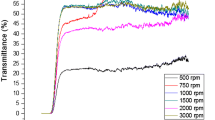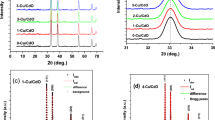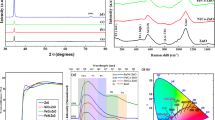Abstract
3 mol% Cu-doped ZnO (CZO) transparent p-type thin films were deposited on glass substrates by sol–gel dip coating technique, and the influence of various chelating agents such as monoethanolamine (MEA), diethanolamine (DEA) and triethanolamine (TEA) on structural, morphological, optical, and electrical properties of CZO thin films was investigated. The XRD results showed that CZO-DEA and CZO-TEA samples have hexagonal Wurtzite structure which homogenously grown in all direction while CZO-MEA thin film was highly oriented along the (002) direction. In addition, the grain size of thin films is about 16.2–19.4 nm, which the smallest grain size belongs to CZO-MEA. FESEM images showed the wrinkled like morphology of the CZO-MEA thin film consists of spherical nanograins in compared with spherical shape of other samples. The electrical measurements revealed the p-type conductivity of samples. Also, CZO-MEA sample exhibited the highest mobility and carrier concentration values of 26.2 cm2/Vs and 2.32 × 1014 cm−3, respectively. Based on optical studies, the superior optical transmittance of CZO-MEA related to the lowest roughness parameters and better growth along c-axis. Moreover, CZO-TEA thin film showed the lowest band gap (3 eV). The PL spectra showed the CZO-MEA sample has the highest visible emission. CZO-MEA thin film illustrated the more contact angle (hydrophobic behavior). Besides, the most change of contact angle observed in CZO-MEA sample under UV-irradiation.












Similar content being viewed by others
References
V. Bilgin, E. Sarica, B. Demirselcuk, S. Turkyilmaz, Iron doped ZnO thin films deposited by ultrasonic spray pyrolysis: structural, morphological, optical, electrical and magnetic investigations, J. Mater. Sci. 20 (2018), https://doi.org/10.1007/s10854-018-9855-9
M.M. Hassan, W. Khan, A. Azam, A.H. Naqvi, Effect of size reduction on structural and optical properties of ZnO matrix due to successive doping of Fe ions. J. Lumin. 145, 160–166 (2014). https://doi.org/10.1016/j.jlumin.2013.06.024
V. Bilgin, E. Sarica, B. Demirselcuk, S. Turkyilmaz, Iron doped ZnO thin films deposited by ultrasonic spray pyrolysis: structural, morphological, optical, electrical and magnetic investigations. J. Mater. Sci. 18(29), 15315–15320 (2017). https://doi.org/10.1007/s10854-018-8805-x
S. Horzuma, E. Torunb, T. Serina, F.M. Peeters, Structural, electronic and optical properties of Cu-doped ZnO: experimental and theoretical investigation. Phil. Mag. 17(1), 1743–1756 (2016). https://doi.org/10.1080/14786435.2016.1177224
M. Shaban, A.M. ElSayed, Influences of lead and magnesium co-doping on the nanostructural, optical properties and wettability of spin coated zinc oxide films. Mat. Sci. Semicon. Proc. 39, 136–147 (2015). https://doi.org/10.1016/j.mssp.2015.0-4.008
T. Ivanova, A. Harizanova, T. Koutzarova, B. Vertruyen, Optical characterization of sol–gel ZnO:Al thin films. Superlattices Microstruct. 85, 101–111 (2015). https://doi.org/10.1016/j.spmi.2015.05.013
T.R. Giraldi, G.V.F. Santos, V.R. Mendonca, C. Ribeiro, I.T. Weber, Effect of synthesis parameters on the structural characteristics and photocatalyticactivity of ZnO. Mater. Chem. Phys. 136, 505–511 (2012). https://doi.org/10.1016/j.matchemphys.2012.07.018
K.D.A. Kumar, V. Ganesh, M. Shkir, S. AlFaify, S. Valanarasu, Effect of different solvents on the key structural, optical and electronic properties of sol–gel dip coated AZO nanostructured thin films for optoelectronic applications. J. Mater. Sci. 29, 887–897 (2017). https://doi.org/10.1007/s10854-017-7985-0
I. Winer, G.E. Shter, M.M. Lahav, G.S. Grader, Effect of solvents and stabilizers on sol–gel deposition of Ga-doped zinc oxide TCO films. J. Mater. Res. 26, 1309–1315 (2011). https://doi.org/10.1557/jmr.2011.69
R. Bekkari, L.D. Boyer, R. Mahiou, B. Jaber, Influence of the sol gel synthesis parameters on the photoluminescence properties of ZnO nanoparticles. Mater. Sci. Semicond. Process. 71, 181–187 (2017). https://doi.org/10.1016/j.mssp.2017.07.027
S.H. Yoon, D. Liu, D. Shen, M. Park, D.J. Kim, Effect of chelating agents on the preferred orientation of ZnO films by sol-gel process. J. Mater. Sci. 43, 6177–6181 (2008). https://doi.org/10.1007/s10853-008-2929-y
D.G. Ayana. V. Prusakova. C. Collini. M.V. Nardi. R. Tatti. M. Bortolotti. L. Lorenzelli. A. Chiappini. A. Chiasera. M. Ferrari. L. Lunelli. S. Dire, Sol-gel synthesis and characterization of undoped and Al-doped ZnO thin films for memristive application. AIP Adv. (2016). https://doi.org/10.1063/1.4968192
F.J. Serrao, S.M. Dharmaprakash, Structural, optical and electrical properties of sol–gel prepared Ga:ZnO thin film. Mater. Res. Innov. 20, 470–474 (2016). https://doi.org/10.1179/1433075X15Y.0000000059
M. Chul Jun, S. Uk Park, J. Hyuk Koh, Comparative studies of Al-doped ZnO and Ga-doped ZnO transparent conducting oxide thin films. Nanoscale Res. Lett. 7, 639 (2012). https://doi.org/10.1186/1556-276X-7-639
L. Nulhakim, H. Makino, S. Kishimoto, J. Nomoto, T. Yamamoto, Enhancement of the hydrogen gas sensitivity by large distribution of c-axis preferred orientation in highly Ga-doped ZnO polycrystalline thin films. Mater. Sci. Semicond. Process. 68, 322–326 (2017). https://doi.org/10.1016/j.mssp.2017.06.045
J. Ramesh, G. Pasupathi, R. Mariappan, V. SenthilKumar, V. Ponnuswamy, Structural and optical properties of Ni doped ZnO thin films using sol–gel dip coating technique. Optik 124, 2023–2027 (2013). https://doi.org/10.1016/j.ijleo.2012.06.035
H. Yuan, M. Xu, Q.Z. Huang, Effects of pH of the precursor sol on structural and optical properties of Cu-doped ZnO thin films. J. Alloy. Compd. 616, 401–407 (2014). https://doi.org/10.1016/j.jallcom.2014.07.070
T. Saidani, M. Zaabat, M.S. Aida, A. Benaboud, S. Benzitouni, A. Boudine, Influence of annealing temperature on the structural, morphological and optical properties of Cu doped ZnO thin films deposited by the sol–gel method. Superlattices Microstruct. 75, 47–53 (2014). https://doi.org/10.1016/j.spmi.2014.07.015
A.R. Nimbalkar, M.G. Patil, Synthesis of highly selective and sensitive Cu-doped ZnO thin film sensor for detection of H2S gas. Mater. Sci. Semicond. Process. 71, 332–341 (2017). https://doi.org/10.1016/j.mssp.2017.08.022
S. Yang, Y. Zhang, D. Mo, Spectroscopic ellipsometry studies of sol-gel-derived Cu-doped ZnO thin films. Thin Solid Films 571, 605–608 (2014). https://doi.org/10.1016/j.tsf.2014.02.097
K. Joshi, M. Rawat, S.K. Gautam, R.G. Singh, R.C. Ramola, F. Singh Band gap widening and narrowing in Cu-doped ZnO thin films. J. Alloy. Compd. 680, 252–258 (2016). https://doi.org/10.1016/j.jallcom.2016.04.093
N.H. Hashim, S. Subramani, M. Devarajan, A.R. Ibrahim, Structural and surface characterization of undoped ZnO and Cu doped ZnO using sol–gel spin coating method. J. Mater. Sci. 27, 3520–3530 (2015). https://doi.org/10.1007/s10854-015-4187-5
S.B. Yahia, L. Znaidi, A. Kanaev, J.P. Petitet,, Raman study of oriented ZnO thin films deposited by sol–gel method. Spectrochim. Acta A Mol. Biomol. Spectrosc. 71, 1234 (2008). https://doi.org/10.1016/j.saa.2008.03.032
K. Thongsuriwong, P. Amornpitoksuk, S. Suwanboon, The effect of aminoalcohols (MEA, DEA and TEA) on morphological control of nanocrystalline ZnO powders and its optical properties. J. Phys. Chem. Solids 71, 730–734 (2010). https://doi.org/10.1016/j.jpcs.2010.01.008
P.H. Vajargah, H. Abdizadeh, R. Ebrahimifard, M.R. Golobostanfard, Sol–gel derived ZnO thin films: Effect of amino-additives. Appl. Surf. Sci. 285, 732–743 (2013). https://doi.org/10.1016/j.apsusc.2013.08.118
K. Bandopadhyay, J. Mitra, Zn interstitials and O vacancies responsible for ntype ZnO: what do the emission spectra reveal, RSC 5, 23540–23547 (2015). https://doi.org/10.1039/C5RA00355E.
V. Mușat, A. Tabacaru, B. Vasile. V. A. Surdu. Size-dependent photoluminescence of zinc oxide quantum dots through organosilane functionalization. RSC 4, 63128–63136 (2014). https://doi.org/10.1039/C4RA10851E.
J. Chauhan, N. Shrivastav, A. Dugaya, D. Pandey, Synthesis and Characterization of Ni and Cu Doped ZnO. J. Nanomed. Nanotechnol. (2017). https://doi.org/10.4172/2157-7439.1000429
S. Muthukumaran, R. Gopalakrishnan, Structural, FTIR and photoluminescence studies of Cu doped ZnO nanopowders by co-precipitation method. Opt. Mater. 34, 1946–1953 (2012). https://doi.org/10.1016/j.optmat.2012.06.004
E. Muchuweni, T.S. Sathiaraj, H. Nyakotyo, Synthesis and characterization of zinc oxide thin films for optoelectronic applications. Heliyon, 3, e00285 (2017), https://doi.org/10.1016/j.heliyon.2017.e00285
L.E. Mir, F. Ghribi, M. Hajiri, Z. Ben Ayadi, K. Djessas, M. Cubukcu, H.J. Bardeleben, Multifunctional ZnO:V thin films deposited by rf-magnetron sputtering from aerogel nanopowder target material. Thin Solid Films 519, 5787–5791 (2011). https://doi.org/10.1016/j.tsf.2010.12.198
R. Vinodkumar, K.J. Lethy, P.R. Arunkumar, R. Renju, N.Venugopalan Krishnan, Pillai, Effect of cadmium oxide incorporation on the microstructural and optical properties of pulsed laser deposited nanostructured zinc oxide thin films. Mater. Chem. Phys. 121, 406–413 (2010). https://doi.org/10.1016/j.matchemphys.2010.01.004
R. Kh. Sh Sendi. Mahmud, Stress control in ZnO nanoparticle-based discs via high-oxygen thermal annealing at various temperatures. J. Phys. Sci. 24, 1–15 (2013)
J. Chen, D. Chen, J. He, S. Zhang, Z. Chen, The microstructure, optical, and electrical properties of sol–gel-derived Sc-doped and Al–Sc co-doped ZnO thin films. Appl. Surf. Sci. 255, 9413–9419 (2009). https://doi.org/10.1016/j.apsusc.2009.07.044
Z. Bazhan, F.E. Ghodsi, J. Mazloom, The surface wettability and improved electrochemical performance of nanostructured CoxFe3–xO4 thin film. Surf. Coat. Technol. 309, 554–562 (2017). https://doi.org/10.1016/j.surfcoat.2016.12.024
J.B. Miller, H.J. Hsieh, B.H. Howard, E. Broitman, Microstructural evolution of sol–gel derived ZnO thin films. Thin Solid Films 518, 6792–6798 (2010). https://doi.org/10.1016/j.tsf.2010.06.032
Glossary of surface texture parameters (2014) Michigan metrology. http://www.michmet.com. Accessed 14 Jan 2018
R. Swanepoel, Determination of the thickness and optical constants of amorphous silicon. J. Phys. E: Sci. Instrum. (1983), https://doi.org/10.1088/00223735/16/12/023
I. Chambouleyron, J.M. Martinez, Estimation of optical constants of thin films using unconstrained optimization. J. Comput. Phys. 151, 862–880 (1999). https://doi.org/10.1006/jcph.1999.6224
F.E. Ghodsi, F.Z. Tepehan, Heat treatment effects on the optical properties of sol-gel Ta2O5 thin films. Sol. Energy Mater. Sol. Cells 59(4), 367–375 (1999). https://doi.org/10.1016/S0927-0248(99)00056-2
E. Burstein, Anomalous optical absorption limit in InSb. Phys. Rev. 93, 632–633 (1954). https://doi.org/10.1103/PhysRev.93.632
W.E. Mahmoud, F. Al-Marzouki, S. Al-Ameer, F. Al-Hazmi, Synthesis and characterization of one-dimensional vertically aligned Sb-doped ZnO nanowires. J. Appl. Crystallogr. 45, 182–185 (2012). https://doi.org/10.1107/S0021889812001665
A. Monemdjou, F.E. Ghodsi, J. Mazloom, The effects of surface morphology on optical and electrical properties of nanostructured AZO thin films: fractal and phase imaging analysis. Superlattices Microstruct. 74, 19–33 (2014). https://doi.org/10.1016/j.spmi.2014.06.002
S. Vempati, J. Mitra, P. Dawson, One-step synthesis of ZnO nanosheets: a blue-white fluorophore. Nanoscale Res. Lett. (2012). https://doi.org/10.1186/1556-276X-7-470
G. Zeng, Y. Duan, S. Li, X. Yang, W.Cai Xu, Blue luminescence of ZnO nanoparticles based on non-equilibrium processes: defect origins and emission controls. J. Adv. Funct. Mater. 20, 561–572 (2010). https://doi.org/10.1002/adfm.200901884
R. Bekkaria, L. laanaba, D. Boyerb, R. Mahioub, B. Jaberc, Influence of the sol gel synthesis parameters on the photoluminescence properties of ZnO nanoparticles. Mater. Sci. Semicond. Process. 71, 181–187 (2017). https://doi.org/10.1016/j.mssp.2017.07.027
K. Bhavsar, D. Ross, R. Prabhu, P. Pollard, LED-controlled tuning of ZnO nanowires’ wettability for biosensing applications. J. Nano Rev. (2015). https://doi.org/10.3402/nr.v6.26711
E.L. Papadopoulou, M. Barberoglou, V. Zorba, A. Manousaki, A. Pagkozidis, E. Stratakis, C. Fotakis, Reversible photoinduced Wettability Transition of Hierarchical ZnO Structures. J. Phys. Chem. 113, 2891–2895 (2009). https://doi.org/10.1021/jp8085057
Acknowledgements
The authors would like to acknowledge the University of Guilan Research Council for the support of this work.
Author information
Authors and Affiliations
Corresponding author
Additional information
Publisher’s Note
Springer Nature remains neutral with regard to jurisdictional claims in published maps and institutional affiliations.
Rights and permissions
About this article
Cite this article
Dinmohammadi, M., Ghodsi, F.E. & Mazloom, J. Effect of chelating agents on the surface parameters and optical constant of CZO thin films by sol–gel process. J Mater Sci: Mater Electron 30, 5947–5958 (2019). https://doi.org/10.1007/s10854-019-00894-0
Received:
Accepted:
Published:
Issue Date:
DOI: https://doi.org/10.1007/s10854-019-00894-0




